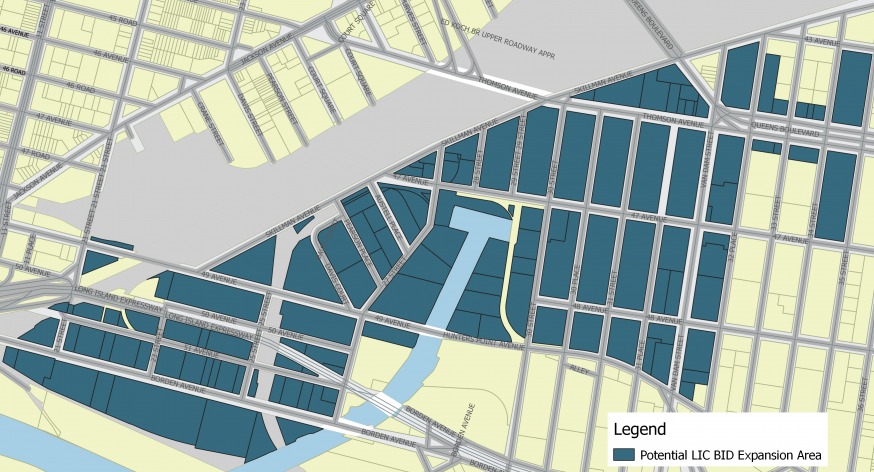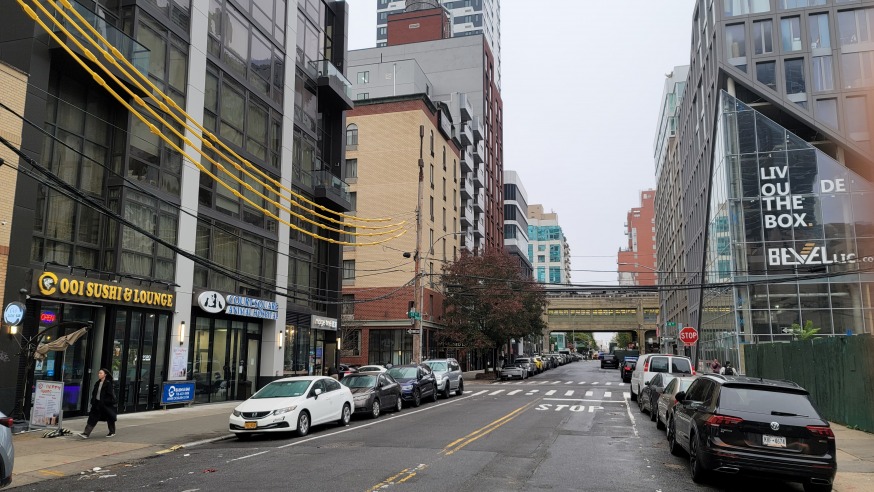
The Long Island City Partnership is planning to expand the boundaries of its Business Improvement District. It will hold meetings over the next two weeks for the public to weigh in on its plans. If the new proposal moves forward, the BID would include properties along Crescent Street, between 42nd Road and 43rd Avenue, pictured, and much more. (Photo by Michael Dorgan)
Oct. 24, 2022 By Michael Dorgan
The LIC Partnership is planning to expand the boundaries of its Business Improvement District and will hold public meetings over the next two weeks for the residents to weigh in on its proposal.
The organization’s existing BID was established in 2005 covering the commercial areas of Queens Plaza/Court Square as well as portions of Hunters Point. In 2017, it was expanded to include commercial properties fronting Northern Boulevard, Queens Plaza South, Jackson Avenue, Vernon Boulevard and 44th Drive.
If the new proposal moves forward, the BID would spread to the east–which the BID refers to as its East Expansion– and to west of its existing district, as in the West Expansion.
The East Expansion would be substantial — essentially stretching east along Skillman Avenue as far as 35th Street and encompassing properties from Queens Boulevard in the north to Borden Avenue in the south.

East Expansion (LIC Partnership website)
The West Expansion would consist of extending two current sections of the LIC Partnership’s BID.
For instance, one section of the West Expansion would expand the Queens Plaza/Court Square area by extending to the east and west of Jackson Avenue. This area going east would extend north along Northern Boulevard as far as 39th Street.
The second section of the West Expansion would expand the Vernon Boulevard area by extending north along Vernon Boulevard and then swinging east along Queens Plaza north as far as 21st Street.
Business operators in these areas, the LIC Partnership says, have voiced the need for the organization’s services, which include assistance with sanitation, marketing, beautification and holiday lighting.
The proposed budget for the East Expansion is $650,000 while the budget for the West Expansion would be $375,000, according to the LIC Partnership. The funds would come via special assessments on property owners in those districts.

West Expansion (LIC Partnership website)
Laura Rothrock, the president of LIC Partnership, said the organization spent more than a year conducting surveys and feasibility studies with potential stakeholders that operate near the current BID district to see if it made sense to expand.
The organization then established two steering committees — made up of local property and business owners, residents and community stakeholders – that evaluated the research and put the preliminary maps together. One committee is focusing on the East Expansion while the other is looking into the West Expansion.
“The steering committees evaluated and approved expansion boundaries that are based on the evolving needs of the district and that consider the feedback from property owners and tenants,” Rothrock said.
The expansion process will be spearheaded by Rothrock who is viewed as an expert when it comes to the inner workings of Business Improvement Districts. Rothrock, who was named president of the LIC Partnership in August, has worked on BID formations and expansions throughout her career, the organization said.
The LIC Partnership will hold public outreach meetings at LaGuardia Community College, located at 31-10 Thomson Ave., and the Sculpture Center, located at 44-19 Purves St., where the plans will be discussed. The public will get a chance to ask questions at the meetings.
The establishment of the steering committees represented the first of a three-phase process the LIC Partnership must follow in order to expand its BID boundaries.
The second phase consists of hosting public outreach meetings and gathering feedback from the relevant stakeholders. The data is then submitted to the Dept. of Small Business Services (SBS) for approval.
Once the SBS signs off on the plans the third and final phase begins which consists of getting legislative approval, much like a rezoning.
This phase also includes a review of the plans and public hearings as well as recommendations and votes from Community Boards 1 and 2, the Borough Board, the City Planning Commission, the City Council, the Mayor, and the State Comptroller.
Legislative approval is required since the city assists with the collection of the assessments and oversees their workings.
The BIDs are funded by special assessments levied on commercial property owners within the district via property tax billing. The city then allocates the funds to the BID organization so it can commission various services and improvements to the district.
The property owners with larger properties pay more than those with smaller properties. Additionally, landlords typically pass on the cost of the assessment to their tenants.
For more information on the proposal, click here.
LIC Partnership Upcoming Public Meetings
East Expansion
Oct. 26 — noon to 1 p.m. at LaGuardia Community College, located at 31-10 Thomson Ave., inside Room E-111 at the E Building.
Nov. 1 — 3 p.m. 4 p.m. at the Sculpture Center, located at 44-19 Purves St.
West Expansion
Oct. 26 – 9 a.m. to 10 a.m. at LaGuardia Community College, located at 31-10 Thomson Ave., inside Room E-111 at the E Building.
Nov. 1 – 6 p.m. to 7 p.m. at the Sculpture Center, located at 44-19 Purves St.

If the new proposal moves forward, the BID would include businesses along Crescent Street, between 42nd Road and 43rd Avenue, pictured. (Photo by Michael Dorgan)
3 Comments

Expansion is a BAD idea
WHAT ARE BIDs?
BIDs are allies of big real estate, and are an arm of NYC government. They remove autonomy and ability to speak out as communities, small businesses, and small real estate owners. NYC government and real estate like to control recipients of public funding, and primarily remove community resistance to rezoning. BIDs cannot speak out against elected officials because they rely on them for additional grants.
HOW ARE BIDs FUNDED? Individual renters of storefronts are taxed monthly, with landlords then remitting the funds to the City, which refunds it back for BID operation. Elected officials, and Small Business Services also give additional grants. Thus, you will not find a BID Executive Director or BID Board able to dispute the agenda of elected officials or city agencies.
WHO STARTS THEM AND WHY? They are started by local landowners seeking to increase their rents and/or resale values. They do not originate from community residents, or small firms. They were devised to help landlords of “slum” areas, in blight, to climb back into safety and trade. But, in the past decade, they have been used to extend real estate goals, not necessarily those of small business or communities.
DO THEY RAISE PROPERTY VALUE? Yes. Have Queens Blvd. and Greenpoint STORES benefitted from our BID? We have had probably 100+ small businesses priced out, with no recourse. One beauty salon had two weeks to vacate when their rent went from $1400 to over $10,000. They are mainly run by real estate connected officers, who have no term limits. But where is the “coolest” strip in Sunnyside Woodside? Skillman Avenue, which has no BID. We have twice turned back a BID expansion North with community petitions. Before the BID, we had Restaurant Week, Tastes, and holiday lights.
BENEFITS/WEAKNESSES: The landlords are allowed to pass on their storefront renters a monthly fee to pay for holiday lights, administrative pay, office, more sanitation, security, and small biz promo. But when a local business in the BID asked for help when their property tax doubled, the BID said it was unable to help. When asked to speak up against city policies such as a DOT or MTA directive, their hands are tied. Why? Because BIDs are an arm of City government. Back when John Vogt was Chamber president, he often battled the city to help us locally. Now, as Chair of the BID since 2008, his hands are tied.
WHO IS BEHIND EXPANSION OF BIDs? Big real estate and elected officials to whom they donated. Why? To raise rents and resale numbers. Sadly, when elected officials say they are “helping small business” when donating or working with BIDs, they are not. They are helping big real estate extend its already strong reach. BIDs assist in removing community and small biz input on real estate issues.
PERMANENT: Once installed, BIDs are nearly impossible to dismantle. To establish a BID, 51% of landowners must sign, and community must agree. We have already seen how overdevelopment took over LIC. The bigger the BID, the fewer people will be able to speak up at all — for instance, against Sunnyside Yards development, which, in this area, along with endless glass skyscrapers, is the big real estate’s endgame.
I agree with everything you said Patricia.
WHEN will developers ever stop ruining LIC. I guess never.